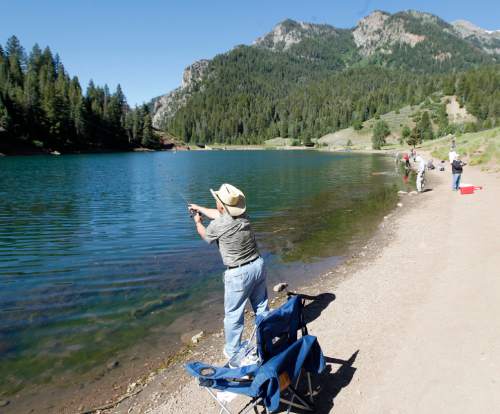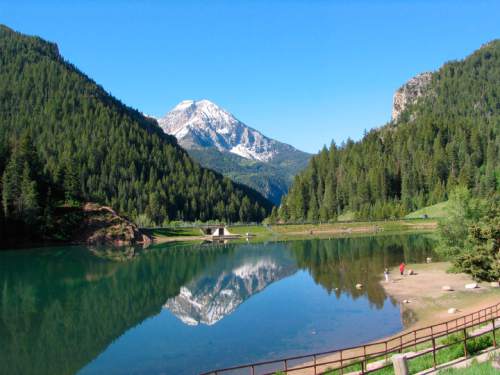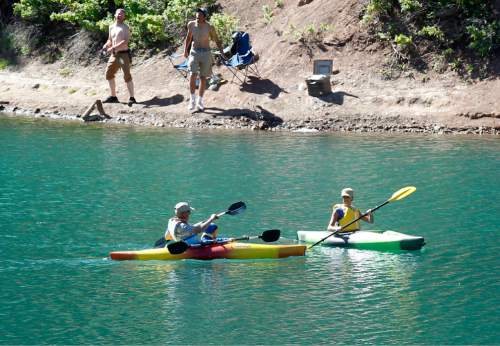This is an archived article that was published on sltrib.com in 2016, and information in the article may be outdated. It is provided only for personal research purposes and may not be reprinted.
Construction has started on a $7.3 million dam-rehabilitation project that will close a busy fishing destination in American Fork Canyon for the rest of the year.
Federal authorities have drained Tibble Fork Reservoir and are replacing its half-century-old earthen dam with a structure that is 15 feet higher and enlarging the reservoir's surface area from 9.8 acres to 21.6 acres, according to the Natural Resources Conservation Service (NRCS). The water level will rise 9 feet, increasing storage by 120 to 180 acre-feet, depending on final design parameters.
"We've made many engineering advances since Tibble Fork was built in 1966," said Bronson Smart, NRCS state engineer for Utah. "This rehabilitation project will give us the opportunity to increase water-storage capacity — good for both agriculture and recreation — make much needed improvements to stability, and extend the dam's life by more than 50 years."
While canyon visitors won't be able to use the reservoir, they can drive past to get to the Granite Flat campground, Silver Lake Flat and various trailheads accessing Box Elder Peak and the upper reaches of American Fork Canyon.
The road across the dam will be closed, but a temporary road will provide access to 42 summer homes on the other side of Tibble Fork Creek from State Route 144, according to Paul Gauchay, acting district ranger for the Uinta-Wasatch-Cache National Forest's Pleasant Grove district.
"We realize this is a popular area," Gauchay said. "Once the project is complete, it will enhance the recreational opportunities in that area. The reservoir will be larger, and it improves shoreline access."
The Division of Wildlife Resources regularly stocks the reservoir, dropping 14,000 rainbow trout each year. These waters support brown and brook trout, too, drawing thousands of anglers to its shores, which have been eroded by relentless foot traffic. Wasatch Front residents also enjoy this area for hiking, camping, motorized use, boating and horseback riding.
About a third of the 1.9 million annual visitors to American Fork Canyon go to Tibble Fork, according to Sarah Flinders, a Forest Service recreation staff officer.
Most of the Tibble Fork parking will be used as a construction staging ground, so recreational trailer parking and unloading will be challenging. Flinders urged visitors to pick up an information sheet at the booth as they enter the canyon. Visitors must park with all four tires off the pavement and are encouraged not to ride dirt bikes or off-highway vehicles on county roads.
This summer, construction crews will pile 93,000 cubic yards of fill on the dam's 450-foot-long crest and its downstream side and will rip-rap the upstream side. The fill will come from a "borrow" area on the upstream side of the reservoir's enlarged impoundment.
The project is needed to preserve the dam's usefulness, which provides irrigation for the North Utah County Water Conservancy District, and to protect public safety. Sedimentation is reducing its storage capacity by 2.8 acre-feet a year and will render the dam useless for water storage or flood control in about eight years, according to an environmental review. A dam failure would imperil 140 homes and two schools in Highland and Alpine, towns at the mouth of the canyon.
The feds are covering $5 million of the project's cost through the Department of Agriculture's Small Watershed Rehabilitation Program, with the $2.3 million balance covered by the water district.
The project will create a beach area on the reservoir's north shore, where sand or gravel will be spread around so anglers and visitors won't have to stand in muck as the lake level recedes during the summer when the reservoir is tapped for irrigation. The 83-stall parking lot will be reconfigured and a 1-acre parking area will be added below the dam.
Under the watershed-rehabilitation program, the NRCS last year improved the Silver Lake Flat Dam just upstream, raising its lake level 20 feet. Next year, the agency expects to embark on a much larger effort to rehabilitate Emery County's Millsite Dam.
Brian Maffly covers public lands for The Salt Lake Tribune. Maffly can be reached at bmaffly@sltrib.com or 801-257-8713. Twitter: @brianmaffly









